Raid campaign "Cormoran." Australian duel
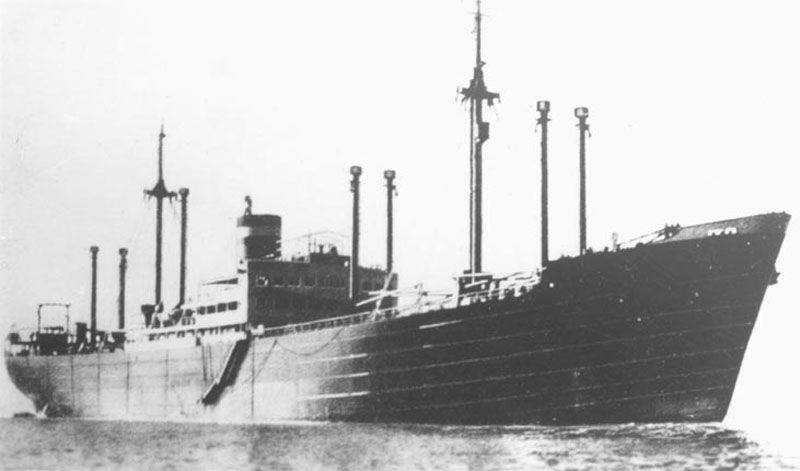
Fregatten-captain Theodore Detmers thoughtfully lowered his binoculars. Their enemy - strong, fast, and deadly - slowly ripped the Pacific waves in a single half and a half kilometers from its ship. Confident in his abilities, the opponent carelessly made friends with those whom the commander of the Australian cruiser "Sydney" taken for a harmless huckster Dutch "Straat Malacca." The cruiser started flashing insistently and demandingly with the searchlight: “Show your secret call sign.” Stock tricks and tricks over. The word was for the guns.
From cargo ship to raiders
Having lost almost the entire merchant fleet as a result of World War I and the Versailles Peace Treaty that followed it, Germany had to rebuild it. By the beginning of World War II, the German merchant fleet reached 4,5 million gross tons and was relatively young - a large number of ships and vessels were built in the 30s. Due to the widespread use of diesel engines, the Germans managed to create ships with a long range of navigation and autonomy. 15 September 1938 of the year in Kiel from the stocks of the shipyard “Germanienverft”, which belonged to the Krupp concern, the ship “Stirmark” was launched. He and Ostmark of the same type were built on the request of HAPAG for long-term commercial shipments. "Stirmark" was a large vessel with a displacement of 19 thousand tons, equipped with diesel engines with a total capacity of 16 thousand liters.
The ship failed to start a career as a peaceful bulk carrier. The readiness of the completed "Stirmark" coincided with the exacerbation of the political situation in Europe and the beginning of the war. The naval department had views of a large ship with a long range and mobilized it. At first it was thought to be used as a transport, but then the Stirmark found a more effective use. It was decided to convert it into an auxiliary cruiser, the benefit of all the data for this role he possessed. The newest cargo ship received the index "auxiliary vessel 41". Soon the “41 ship” was transferred to Hamburg, to the Deutsche Vert factory, where it took up the vacant seat after the auxiliary cruiser “Thor”. In all accompanying documentation, the future raider began to be designated as "auxiliary cruiser №8" or "HSK-8".
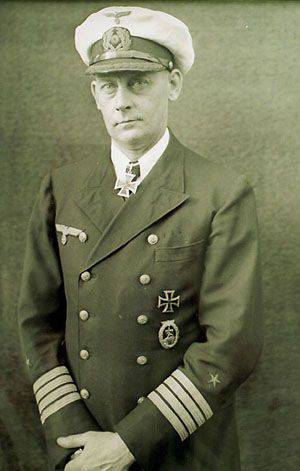
17 July 1940 was appointed 37-year-old Corvette-Captain Theodore Detmers as its commander. He was the youngest commander of auxiliary cruisers. Entered the fleet at the age of 19 years - first served on the old training ships. After receiving the officer's rank, the lieutenant stepped on the deck of the Cologne cruiser. Further way was on destroyers. In the 1935 Maruschka Detmers year old was under the command of «G-11», in 1938, the Korvettenkapitan arrived at the new place of service, to the newest destroyer "Herman Shoman» (Z-7). He met the war, commanding this ship. Soon the Hermann Schöman stood up for repair, and its commander received a new assignment for the auxiliary cruiser under preparation. HSK-8 was prepared in a hurry - he did not receive some of the weapons and equipment planned for installation. Unlike its predecessors, the raider had to be equipped with a radar, but due to technical difficulties (the equipment often broke), the installation was refused. New 37-mm automatic anti-aircraft guns were not installed - they took old ones. In mid-September, running tests were successfully conducted. 9 October 1940, the auxiliary cruiser called "Cormoran" officially joined the kriegsmarine. Later Detmers recalled that for a long time he could not decide on the name for his ship. This suddenly he assisted Günter Gumprih, the future commander of the auxiliary cruiser "Thor." Even when Kormoran was standing at the wall of the shipyard, Detmers met with Rukteshel, the commander of the Widder who had just returned from the march, with whom he discussed plans for a breakthrough into the Atlantic. It was decided that the "Cormoran" will break through the most dangerous, but also the shortest place - Dover channel. In winter, the Danish Strait, according to the Germans, was clogged with ice. However, a radiogram soon arrived from the Sachsen trawler, a weather scout located at these latitudes. The trawler reported that there is a lot of ice, but it is possible to pass through it. The breakout plan was changed in favor of the Danish Strait passage.
In November, 1940, the raider moved to Gotenhafen, where the final refinement and additional equipment was carried out. On November 20, the ship was visited by Grand Admiral Raeder and was pleased with what he saw. "Kormoran" as a whole was ready for the march, however, the mechanics raises concerns not fully tested powerplant. For the final completion of all the tests it took time, and Detmers did not want to wait. The final armament of the Cormoran was six 150-mm guns, two 37-mm guns and four one-gun 20-mm anti-aircraft guns. Two twin-tube 533-mm torpedo tubes were installed. Additional armament included two seaplanes “Arado 196” and torpedo boat type LS-3. Using the large size of the Cormoran, the 360 anchor mines and 30 magnetic mines for the boat were loaded onto it. The raider was instructed to act in the Indian Ocean, in African and Australian waters. Reserve area - the Pacific Ocean. As an additional task, the Cormoran was assigned the mission to supply German submarines located in southern latitudes with new torpedoes and other means of supply. The raider took in the hold 28 torpedoes, a large number of projectiles, medicines and provisions intended for transfer to the submarines.
December 3 1940 years finally prepared for a hike "Cormoran" left Gotenhafen.
To the Atlantic
On the way to the Danish Strait, the raider met with bad weather. 8 December he arrived in Stavanger. December 9, last replenished stocks, went to sea. The 11 “Kormoran” was made up for the Soviet “Vyacheslav Molotov”, but the fears were superfluous - no one discovered the raider. Withstanding a brutal storm, during which the 19-thousandth ship rocked heavily, the 13 of December auxiliary cruiser climbed into the Atlantic. The storm subsided, the visibility has improved - and 18 December was seen first smoke of an unknown ship. However, the raider has not yet reached its "hunting" area, and the stranger left with impunity. Soon the commanders changed their orders and allowed Detmers to act immediately. The raider moved to the south - according to the calculations of the mechanics of their own fuel reserves with rational use would have been enough for at least 7 months of the campaign. The first time "cormorants" no luck with the search for production: with him noticed only one Spanish cargo ship and an American ship. On December 29, an attempt was made to lift a reconnaissance plane into the air, but because of the pitching, the Arado floats were damaged.
The account was finally opened on 6 on January 1941 of the year. As an initiative, the Greek ship “Anthony” was stopped, transporting coal by British freight. After the appropriate procedures, removing the team and 7 live sheep, as well as several machine guns and cartridges for them, "Anthony" sank. The next time luck smiled to the Germans on January 18. Immediately before the onset of darkness, an unknown steamer was seen coming from the raider, which was moving anti-submarine zigzag. Detmers knew that the British Admiralty prescribed such actions to civilian courts - a similar instruction had recently been seized by the Atlantis raider. Having approached the 4 mile distance, the Germans first fired flares, and then, when the steamer turned out to be a tanker, did not react, they opened fire. The Briton (and there was no longer any doubt that he was the one) transmitted the RRR signal. The third volley covered the target, and the radio fell silent. When Kormoran got closer, the gun suddenly crashed from the tanker, which managed to make four shots, after which the raider who had resumed the fire set fire to the stern of his victim. With the British Union - the so-called hapless tanker - began to lower boats. The surviving part of the crew was rescued, and the ship was sent to the bottom. Detmers hurried to leave the area as soon as possible - the alarm signal raised by British Union promised unpleasant meetings. To the place of death of the tanker was in full swing Australian auxiliary cruiser "Arua", he managed to fish out of water even eight Englishmen, which shed light on the events occurred here. In British documents, an unknown so far big raider was named “Raider G”.
Command ordered to arrange a stir Maruschka Detmers go south for a meeting with the ship supply "Nordmark", pass on it all the torpedoes and supplies for submarines, and then sent to the Indian Ocean. "Nordmark" was actually ship complex supply - its storerooms, fuel storage facilities and cabins to enjoy a great number of German ships, operating or passing through the southern latitudes, "pocket" battleship "Admiral Scheer" auxiliary cruisers, submarines, Blockade and other vessels security.
Between the islands of Cape Verde and the equator in the afternoon of January 29, a ship resembling a refrigerator was seen from the board of the Cormoran. Pretending to be a “peaceful merchant”, the raider waited until the ship came closer and raised the signal to stop, while Demers ordered to give full speed. After the stranger did not respond, the Germans opened aimed fire to kill. The refrigerator triggered the alarm and stopped. With him lowered the boat. The ship "African Star" did transport 5700 tons of frozen meat from Argentina to the UK. His crew was taken on board, and the Afrik Star, the Germans were forced to flood - as a result of the shelling it was damaged. The refrigerator sank slowly, and a torpedo was launched to speed up the process. As the raider victim raised the alarm, the Cormoran left the area at full speed. Already at night the signalmen examined the silhouette in which the merchant ship was identified. The resulting orders to stop were ignored, and auxiliary cruiser opened fire at first lighting, and then live ammunition. The enemy initially responded from the stern gun, which, however, was soon silenced. The steamship stopped the cars - the boarding party discovered that this was the British ship Euriloch, sailing with 16 dismantled heavy bombers to Egypt. Eurylokh lost its course and stayed away from the coast. The enemy radio stations were buzzing on the air with an enraged, disturbed hive, and the Germans again had to expend such a valuable torpedo for a quick reprisal of their prey.
Taking on board the crew of Euryloch, Cormoran moved to a rendezvous with the Nordmark in a special area called Andalusia. On February 7, the meeting took place. The company "Nordmark" was a refrigerated vessel "Dukez", a trophy "Admiral Scheer." The next day, the raider received 1300 tons of diesel fuel, and 100 beef carcasses and more than 200 thousand eggs were shipped from the refrigerator. 170 prisoners and mail were sent to the Nordmark. On February 9, the transshipment was completed, and the Cormoran finally set off for the Indian Ocean. On the way to the Cape of Good Hope, Detmers met with the Penguin raider, who carefully "grazed" the whole trophy whaling flotilla. Captain tsurzee Krueder proposed one of the whalers as an intelligence agent at the beck and call, but his colleague refused. The trophy was not enough, in his opinion, fleet.
Bad weather did not allow to put up a mine can at Walvis Bay (Namibia). February 18 crashed in the engine room. Due to bearing failures, diesel engines No.2 and No.4 failed. Detmers sent an urgent request to Berlin with a request to send a submarine or another blockade of at least 700 kg of babbitt for the manufacture of new bearings. He was promised to fulfill this request as soon as possible, the trip to the Indian Ocean was temporarily canceled. The raider was ordered to act in the South Atlantic for the time being and wait for the “package”. While in the engine room, specialists from cash stocks made new parts of bearings, 24 February got in touch with Detmers Penguin and offered to transfer X kg of babbitt to 200. 25 February, both raiders met - an exchange of necessary materials and movies for the team's entertainment took place. “Cormoran”, meanwhile, continued to suffer from constant damage to the engine room. The reserves allocated by "Penguin" should have been enough for the first time. March 15 held a meeting with one of the submarine wards, U-105, to which several torpedoes were shipped, fuel and provisions. With the hunt raider has not had any luck.
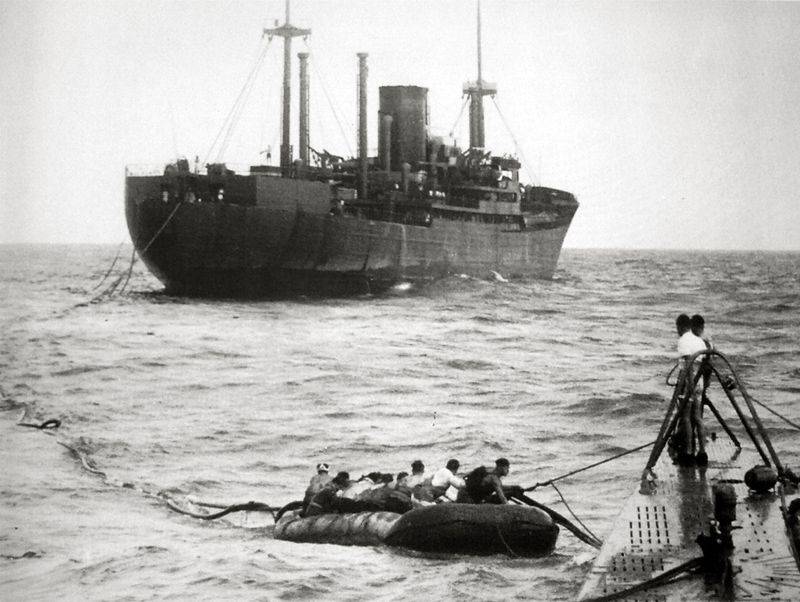
A long break in search of new prey ended on March 22. "Cormoran" captured a small English tanker "Agnita", going to ballast. The vessel was in a very mediocre state and was sunk without regret. The most valuable loot was a minefield map near Freetown, indicating safe passage. Three days later, almost in the same area in the morning 8 tanker was seen coming in ballast toward South America. He did not respond to the request to stop - fire was opened. Since the ship seemed to be new, Demers ordered to fire carefully, so as not to cause severe damage. After several volleys, the fugitive stopped the car. The large-scale (11 thous. Tons) tanker Kanadolight became the prey of the raider. The ship was almost new, and it was decided to send it with a prize party to France. The prize successfully reached the mouth of the Gironde 13 April.
Fuel and food consumption was quite extensive, and Detmers went to a new meeting with the supply provider Nordmark. March 28 ships met, and the next day, two submarines pulled up here. One of them, U-105, passed a long-awaited babbit to the raider, which, however, turned out to be not so much. Detmers' plans included a rendezvous with another support vessel, the Rudolf Albrecht, which marched from Tenerife on March 22. Having replenished the fuel, “Cormoran” 3 of April met with a new supplier, but, unfortunately, there was no babbit on it. "Rudolf Albrecht" gave a lot of fresh vegetables, fruits, newspapers, magazines, a live pig and a puppy. Saying goodbye to the tanker, "Cormoran" went to the south-east.
9 April, the raider was spotted smoke at the stern - some boat moved one course with him. After waiting for the distance to decrease, the Germans dropped their disguise. Again, the British ignored the order to stop and not use the radio. "Cormoran" opened fire, achieving several hits. Dry vessel "Kraftsmen" stopped. A strong fire broke out at its stern. The boarding party failed to immediately send the Englishman to the bottom - he did not want to sink. It was all about his cargo - a giant anti-submarine network for Cape Town harbor. And only after the torpedo hit, the rebellious "Kraftsman" sank. The next day, the raider’s radio operators received a radio message that brought a pleasant news: Detmers assigned the title of Frigate Captain. 12 April, the Germans intercepted the Greek ship "Nikolaos DL", loaded with timber. And again, not without shooting. Taking the prisoners, "Cormoran" put in sacrifice several 150-mm shells under the waterline, not counting the charges that had been blown up earlier. Greek sinking slowly but Maruschka Detmers did not spend on it torpedo, believing that the sink and so.
It was time to replenish the fuel again, and Cormoran once again went to the meeting point with Nordmark. 20 April in the ocean met a whole group of German ships. In addition to the Nordmark and the Cormoran, there was another auxiliary cruiser, the Atlantis, with the supply ship Alsterufer. Detmers' ship received 300 tons of diesel fuel and two hundred 150-mm projectiles from the Alsterufer. The work of diesel engines was more or less normalized, and the raider finally received an order to follow to the Indian Ocean, where, after bidding farewell to his compatriots, he headed for April 24.
In the indian ocean
In early May, the ship rounded the Cape of Good Hope. The waters of the Indian Ocean met "Cormoran" with a strong storm that raged for four days. When heading north, the weather began to gradually improve - the raider repainted, disguised as a Japanese vessel, the Sakito Maru. 9 May it became known about the death of the auxiliary cruiser "Penguin", and then were ordered to meet at the appointed place with the ship supply "Altsertor" and intelligence "Penguin" - a former whaler "adjutant". The ships met on 14 in May, and to the great dismay of Demers, on orders from the command, he had to transfer 200 tons of fuel to the Altsertor. The supplier, in turn, replenished the crew of the Cormoran with members of their crew in return for those who went to France on the Canadolite tanker.
Then dragged monotonous weekdays. For nearly a month, Cormoran plied the Indian Ocean without meeting goals on its way. June 5 was again changed camouflage - now the raider looked like Japanese Kinka Maru transport again. Twice the ship "Arado" went to reconnaissance flight, but both times to no avail. Once there was a brightly consecrated ship that turned out to be American. Another time, an unknown passenger ship was frightened by a sudden smoke installation. Seeing that the hunt was not going on, Detmers decided to try his luck in a mine war - 360 mines were still waiting in the wings and were a dangerous and burdensome load. 19 June "Cormoran" entered the waters of the Bay of Bengal, whose shores abounded in major ports. At the exit of them the Germans and planned to put their mines. First of all it concerned Rangoon, Madras and Calcutta. However, even here the raider was not lucky. When Madras was no more than two hundred miles away, smoke first appeared on the horizon, and then the silhouette of a large ship, similar to an English auxiliary cruiser, began to emerge. This kind of meeting was not part of Demers plans, and he began to leave at full speed. For an hour, the unknown pursued the raider, then gradually fell behind, hiding behind the horizon. The Germans were really lucky - it was the British auxiliary cruiser "Canton", who took them for the Japanese. The mine setting at Calcutta was also canceled - a hurricane raged in the area.
The long run of bad luck finally ended on the night of June 26, when a watchman noticed the vessel on duty. Traditionally, the Germans demanded to stop and not use the radio. However, the discovered ship continued to follow as if nothing had happened, without trying, however, to go on the air. Having tapped off orders without signaling several times in a row, the raider opened fire, having achieved almost 30 hits in seven minutes. The vessel began to burn intensively, the boat was lowered from it. The Germans stopped shelling. When the sailors from the boat were taken aboard, it turned out that the stranger was the Yugoslav cargo ship Velebit, which was walking in ballast. At the moment of contact, the captain was in the engine room, and the watch officer did not know (!) Morse code and could not understand what a ship wanted from him. Yugoslav was burning intensely, so Demers did not finish off the crippled ship and went further. A few hours later, already at noon, smoke was seen again. Some ship was heading towards Ceylon. Under the cover of a rain squall "Cormoran" she crept up to his victim at a distance 5 miles. Again the Germans demanded a stop and not go on the air. However, the Australian “Mariba”, which transported almost 5 thousand tons of sugar, did not even think to obey, and immediately broadcast an alarm signal on the radio. The raider's guns crashed, and soon the Australian was already sinking, lowering the boats. Having picked up the crew man 48 and finished off the victim, "Cormoran" hastily left the area. Rader had gone to the south, in the desert, and less-visited the water, where he stayed until July 17. A preventive repair of diesel engines and electrical equipment was carried out. Losing relevance, Japanese makeup was replaced. Posing as a neutral Japanese was already too suspicious, and even dangerous - at night one would have to go with the lights on. In addition, the neutral ship did not have to dramatically change course, moving away from rapprochement with any suspicious ship that could be a British cruiser.
The auxiliary cruiser was disguised as a Dutch merchant Straat Malacca. To heighten realism, a wooden model of the gun was installed on the stern. In the new image of "Cormoran" moved towards the island of Sumatra. Swimming in the tropics made it difficult to store food. For nearly ten days, the crew, replacing each other, dealt with sifting ship stocks of flour, in which there were many bugs and larvae. Stocks of cereals were generally unsuitable for consumption. In contrast to this, the products of long-term storage in numerous refrigerators were well preserved. Continuing southeast, 13 August 200 miles north of Carnarvon (Australia), there was a visual contact with an unknown vessel, but Maruschka Detmers, fearing the presence of a number of military ships, ordered not to pursue the stranger. The raider headed back to Ceylon.
August 28 1941, the Germans for the first time after coming out of Norway saw the ground - it was the top of the mountain Boa Boa island Ang, which is located at the south-western coast of Sumatra. The Indian Ocean was deserted - even the flights of a seaplane did not bring results. Only 23 September in the evening watch to the great joy of the crew dying from the monotony found running lights going into the ballast of the vessel. Even though these were signs of neutral, Detmers decided to examine him. The stopped ship turned out to be the Greek "Stamathios G. Ambirikos", going with cargo to Colombo. The crew behaved obediently and did not go on the air. Initially, Detmers wanted to use it as an auxiliary mine layer, but the small amount of coal in the Stamatios bunkers made this problematic. After dark, the Greek was sunk by explosive charges.
The raider cruised in the western Indian Ocean to 29 September. The need for resupply forced the "Cormoran" to meet with the next supply ship. It was "Kulmerland", which 3 came out of Kobe on September. The rendezvous was supposed to take place in the secret point "Marius". Arriving there on October 16, the raider met with the waiting supplier. The auxiliary cruiser received almost 4 thousand tons of diesel fuel, 225 tons of lubricating oil, a large amount of babbitt and provisions, designed for 6 months of sailing. In the opposite direction followed by prisoners, five sick crew members and the post office. "Kulmerland" raider parted with October 25, and the "Cormoran" took another engine repair. When the mechanics reported to Detmers that the machines were in relative order, the frigate-captain again went to the Australian coast to place mine cans at Perth and in Shark Bay. However, the German command reported that a large convoy escaped from Perth under the protection of the heavy cruiser "Cornwall", and the "Cormoran" moved towards Shark Bay.
The same fight
19 November 1941, the weather was great, visibility was great. At around 4 hours in the afternoon, the messenger reported to Detmers, who was in the mess room, that smoke was seen on the horizon. Climb the bridge fregatten captain soon found that it is a military ship, which goes to a meeting of the Raider. The Australian light cruiser Sydney returned home after escorting the Zeeland liner carrying troops to Singapore. “Sydney” has already distinguished itself in combat operations in the Mediterranean, sinking the Italian light cruiser “Bartolomeo Colleoni” in battle at Cape Spada. However, in May 1941, the commander of the light cruiser captain rank 1 John Collins, who had extensive combat experience, he has replaced previously served on the bank of Captain Joseph Burnett 1 rank. In many ways, this probably decided the outcome of a future fight.
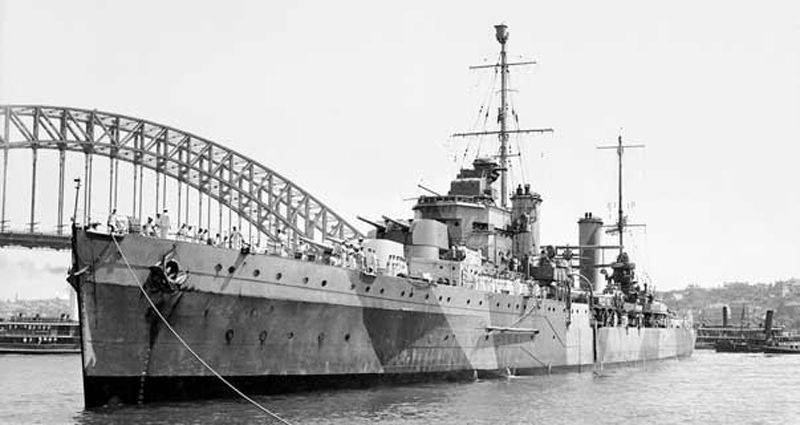
"Sydney" was full of warships, a displacement of almost 9 thousand. Tons and armed with eight 152-mm guns, four 102-mm guns, twelve anti-aircraft machine guns. Torpedo armament was eight 533-mm torpedo tubes. On board there was a seaplane. Maruschka Detmers did not lose his presence of mind and ordered to turn south-west, to the sun shone directly into the eyes Australians. Simultaneously, "Cormoran" gave full speed, however, soon diesel No. XXUMX began to act up, and the speed dropped to 4 nodes. About an hour after the raider was discovered, the cruiser approached 14 miles on the starboard side and ordered it to be identified by a searchlight. "Cormoran" gave the correct call sign "Straat Malakka» «RKQI», but it was raised between the pipe and the foremast, with the right to the stern of the cruiser it almost never seen. Then "Sydney" demanded to specify the destination. The Germans replied: "To Batavia," which looked quite believable. In order to confuse their pursuers, the raider’s radio operators began broadcasting distress signals stating that the Dutch ship had been attacked by an “unknown warship”. Meanwhile, the cruiser was approaching - its nose towers were aimed at the pseudo-buyer. Australians periodically transmitted the signal "IK", which in the international code of signals meant "prepare for a hurricane." In fact, the present “Straat Malacca” should have answered “IIKP” according to the secret code of signals. The Germans chose to ignore repeated requests.
Finally, “Sydney” this protracted comedy began to bother, and they signaled: “Enter your secret call sign. Further silence can only worsen the situation. ” Game over. Each Allied merchant ship had its own individual secret code. The Australian cruiser has almost caught up with the Cormoran and was almost on its traverse, at a distance of just over a kilometer. In response to a request in 17 h. 30 min. the raider lowered the dutch flag and raised the battle flag of the kriegsmarine. In record time in six seconds camouflage shields fell. The first shot lay down with the undershoot, and the second volley of three 150-mm and one 37-mm guns landed on the Sydney bridge, destroying its fire control system. Simultaneously with the second salvo, the Germans defused their torpedo tubes. The main caliber of the cruiser began to respond, but the sun was shining in the eyes of the gunners, and he lay down with the flight. Earned 20-mm anti-aircraft guns and heavy machine guns, preventing the crew of the cruiser to take places according to the combat schedule. At such a distance it was difficult to miss, and the Germans threw a projectile behind the projectile in the Sydney. The seaplane was destroyed, then the Cormoran turned the fire on the nose towers of the main caliber - they were soon disabled. Released torpedo struck the nose of the cruiser in front of the nose tower. The bow of the "Sydney" strongly subsided in the water. Fire on the raider led fodder towers, which went on an independent tip. Australians smeared - nevertheless, three shells hit the Cormoran. The first one broke through the pipe, the second one damaged the auxiliary boiler and disabled the fire main. In the engine room started a fire. The third projectile destroyed the transformers of the main diesel engines. The raider's move has sharply decreased.
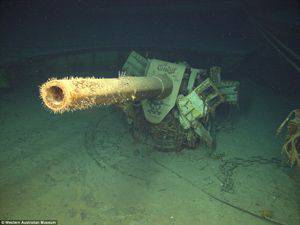
The "Sydney" had a lot worse - the cruiser suddenly turned back. It was clear that the cover of tower B had dropped into the sea. The Australian passed some hundred meters behind the stern of the raider - he was all engulfed in fires. Obviously, the steering on it was badly damaged or incapacitated. Opponents exchanged ineffectual torpedo volleys, and Sydney began to move away with the 10 hub move, moving south. The Cormoran was firing at him while the distance allowed. In 18.25, the fight stopped. The position of the raider was critical - the fire was growing. The staff of the engine room struggled with fire until almost all of them were killed, except for one sailor. The fire was approaching the mine hold, where nearly four hundred mines lay, which Kormoran dragged along during the whole hike, but could not get rid of them.
The Fregatten-Captain realized that the ship could not be saved, and ordered to put explosive cartridges near the fuel tanks. On the water began to lower the life rafts and lifeboats. The first lowered raft overturned, causing almost 40 people to drown. In 24 hours, taking the flag of the ship, Detmers was the last to leave the doomed Cormoran. After 10 minutes, explosive cartridges worked, a detonation of mines occurred - a powerful explosion destroyed the raider's stern, and in 0 h. 35 min. Auxiliary cruiser sank. On the water turned out to be more 300 officers and sailors. 80 people died in battle and drowned after overturning a raft. The weather worsened and life-saving equipment scattered across the water. Soon the coastal steamer picked up one boat and reported this to the command of the Australian Navy, which immediately began a rescue operation. Soon all the Germans were found, although some had to spill rattles for about 6 days.
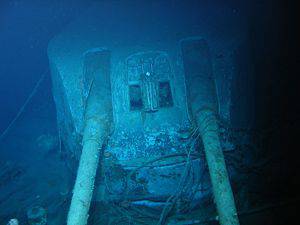
The fate of "Sydney" no news was not, except discarded after two weeks ashore broken lifeboat. Searches that lasted almost 10 days did not yield any results, and the Sydney cruiser was declared 30 on November 1941 of the year dead. For many years the secret of his death remained unsolved. The captured Germans, who had been thoroughly interrogated already on the shore, told of the glow of the fire, which they observed in the place where the cruiser was bursting into flames. Only in March 2008, a special expedition of the Australian Navy discovered the first "Cormoran" and then "Sydney" about 200 miles south-west of Carnarvon. Former opponents lie close to each other - in 20 miles. A layer of water 2,5 kilometers securely covered with its cover of the dead sailors. What events took place in the flaming compartments and decks of the Australian cruiser, how the drama ended, having put this ship to rest at the bottom of the Pacific Ocean, we obviously will never know.
Information